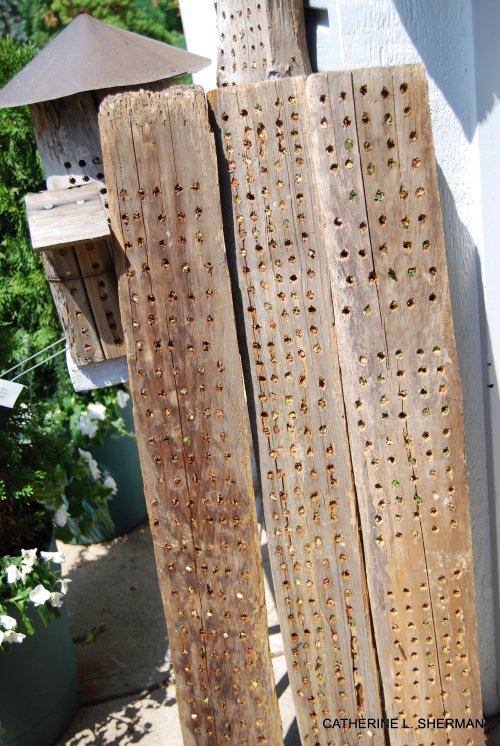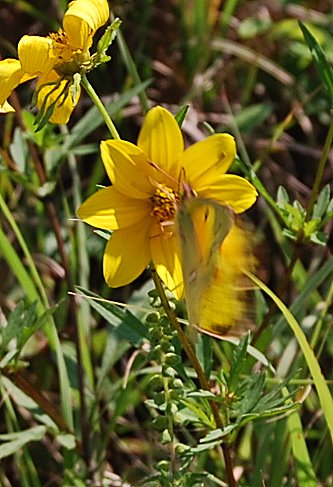
A leaf cutter bee enters its nest drilled in a cedar plank. Leaf cutter bees are solitary but don't mind living close to other leaf cutters. Leaf cutter bees are important pollinators.
Old cedar planks drilled with rows of small holes lean against Jackie G.’s garage in a Kansas City suburb. Leaf cutter bees come and go from the holes, where they have built nests using bits of leaves and petals they have cut from nearby plants.
“I smile when I see the lacey edges,” Jackie says. “It means leaf cutter bees are in the garden.”
Despite the busy bee activity in the planks, very few of the nearby leaves and petals exhibit cut edges and none seem to be damaged very much. Mild-mannered leaf cutter bees are important pollinators, which is one reason Jackie, a master gardener, provides the drilled planks. Drill holes in untreated soft scrap or salvaged wood to make the bee condos. Jackie also volunteers with Monarch Watch, which is dedicated to education about and conservation and research of the Monarch butterfly and other pollinators. The link is in my blogroll on the right.
From Pollinator Partnership, link is in my blogroll on the right.
Pollinators need protection NOWDeclines in the health and population of pollinators in North America and globally pose what could be a significant threat to the integrity of biodiversity, to global food webs, and to human health. A number of pollinator species are at risk. Pollinators are ESSENTIAL TO LIFEAt least 80% of our world’s crop plant species require pollination. Estimates as high as 1 out of every 3rd bite of food comes to us through the work of animal pollinators. Birds, bees, butterflies, and also bats, beetles and even mosquitos are among the myriad creatures which transfer pollen between seed plants. This function is vital for plant reproduction and food production. |
One person who makes bee condos or nest blocks, etc., from reclaimed wood is “Andrew’s Reclaimed.” He makes Mason bee blocks, leaf cutter bee nest blocks, bat houses, elevated pet feeders, planter boxes and more, all from reclaimed wood. He found me on twitter. Somehow he knew I was a bee and butterfly nerd. Here’s a link to his shop: Andrew’s Reclaimed. He lives in the Seattle area, but the shipping costs don’t seem that bad. Even if you aren’t in the market for any of these items, it’s worth checking out his store, because he provides a lot of information.

These lacey edges show that leaf cutter bees have harvested part of the leaves to line their nests.
“Anna’s Bee World” post about Bee engineers.
Information about the Leaf Cutter Bee.
More information about Leaf Cutter bees.
Artsy Homes for Leaf Cutter Bees.

Old planks of untreated wood drilled with holes make great homes for leaf cutter bees.

































